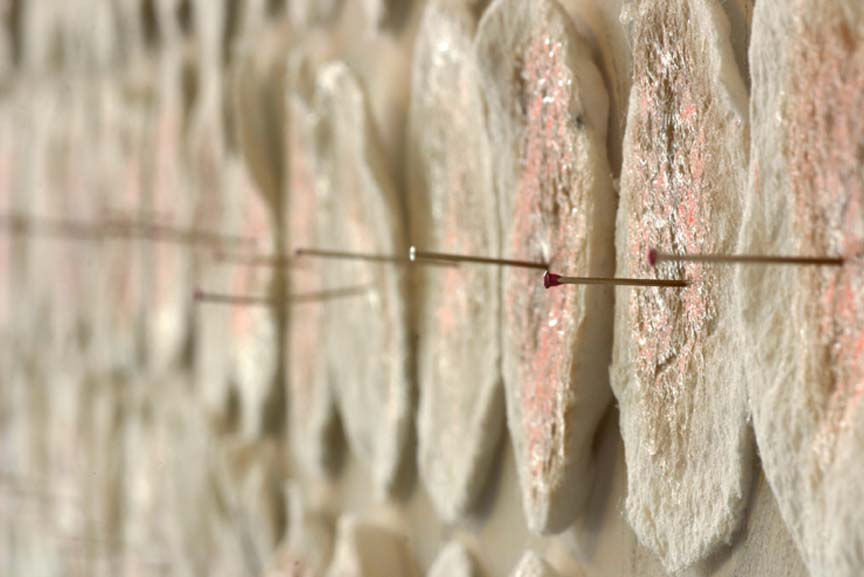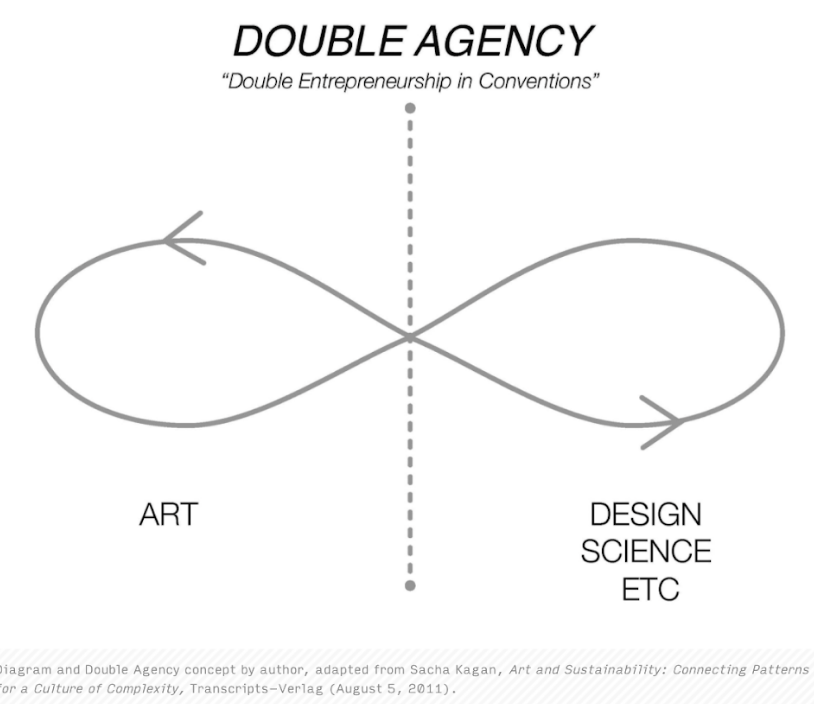Writing in Collaboration (A Practice for Ecological Thinking)
April 19, 2022

Wall sculpture: cotton pads, make-up remover, pins. Dimensions variable.
The used cotton pad removes the thin layer of soot that collects on the artist’s skin during the day. The cotton pad becomes a low-tech biometric sampler collector.
by Maria Patricia Tinajero (PhD candidate, ABD)
Last year, I had two writing projects published. The first one is the article: “Porous Bodies, Toxic Kin: Mapping the Massena Critical Zone,” in the peer-reviewed journal, Writing Visual Culture Vol.10 (2022): “What the World Needs Now is Artists Engaging with Science.” The second is “Hidden Architectures in the Urban Landscape (Brownfields, Landfills, and Phyto-scapes),” for the upcoming book: Design in(g) Environments: Social and Cultural Implications of Architectonic Landscapes, edited by Dr. Sarina Miller.
The overarching theme of these two projects is soil remediation, art, and science. For this issue of the newsletter, I want to reflect on the writing process for these two projects framed as writing collaborations. These writing collaborations align with ecological thinking as a new way to make philosophy. The Massena project began as artistic research; it resulted in an academic article. For the article, we developed a multivalent writing method that brought together dispersed source materials, fields of knowledge, and many different levels of expertise from the people that helped us shape the art project and the article finding the tenuous links between art and sciences. In the introduction to the issue, Dr. Alana Jelinek, chief editor, writes, “we need to pay more attention to how artists are asking questions” (8). This question is central to the article’s focus. We critique the lack of accountability of corporations, governmental agencies, academic institutions, and the public in general for turning a blind eye to the pervasiveness of polychlorinated biphenyls (PCBs). During the two years that we worked on the project, we encountered more challenges than anticipated. However, these difficulties turned out to be the stronger points for the article. We learned to navigate the complicated terrains of multidisciplinary projects that combine art and science. Also, the successful completion of the article gave new insights into the creative side of the artistic project. The writing process gave us a better understanding of the vulnerable spots that art theory and art practice stand in the open field of transdisciplinary work. I want to acknowledge my friend and co-author Lisa Taliano, who made this creative adventure richer. The article contributes to this unfolding conversation between art and science.

Image courtesy of the artist.
The other project explores ecological thinking as a method for developing concepts for addressing the problem of soil pollution. “Hidden Architectures in the Urban Landscape” explores the aesthetic role of multi-functional urban sites (Fig.2). Urban sites designated as brownfields are responsible for a significant part of soil contamination in urban centers. I ask, what lies beneath the hidden architecture of pavement and concrete structures of abandoned city lots? The goal of the chapter is to reveal the invisible presence of the toxic, which does not only hide under our feet but is everywhere. Looking at artist Frances Whitehead’s phytoremediation gardens project, SLOW Clean-up (2008-12), I carry forward this exploration of toxic soil and urban ecology. Soil remediation and urban gardens are entangled sites that share the trace of industrial pollution and neglect. The artwork is designed to show that there are tangible opportunities for soil remediation and the improvement of a community. In closing, I want to acknowledge artist Frances Whitehead for her generosity and willingness to transfer knowledge and expertise during our interview last November. These two writing projects allow soil remediation to be part of making new friends. This is ecological thinking.
